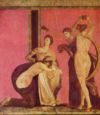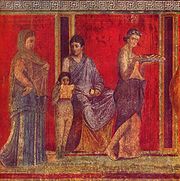
Villa of the Mysteries
Encyclopedia



Roman villa
A Roman villa is a villa that was built or lived in during the Roman republic and the Roman Empire. A villa was originally a Roman country house built for the upper class...
which lies some 400 metres northwest of Pompeii
Pompeii
The city of Pompeii is a partially buried Roman town-city near modern Naples in the Italian region of Campania, in the territory of the comune of Pompei. Along with Herculaneum, Pompeii was destroyed and completely buried during a long catastrophic eruption of the volcano Mount Vesuvius spanning...
, southern Italy
Italy
Italy , officially the Italian Republic languages]] under the European Charter for Regional or Minority Languages. In each of these, Italy's official name is as follows:;;;;;;;;), is a unitary parliamentary republic in South-Central Europe. To the north it borders France, Switzerland, Austria and...
.
Overview
Although covered with metres of ash and other volcanic material, the villa sustained only minor damage in the eruption of VesuviusMount Vesuvius
Mount Vesuvius is a stratovolcano in the Gulf of Naples, Italy, about east of Naples and a short distance from the shore. It is the only volcano on the European mainland to have erupted within the last hundred years, although it is not currently erupting...
in 79 AD
79
Year 79 was a common year starting on Friday of the Julian calendar. At the time, it was known as the Year of the Consulship of Augustus and Vespasianus...
, and the majority of its walls, ceilings, and most particularly its frescoes survived largely undamaged.
The Villa is named for the paintings in one room of the residence. This space may have been a triclinium
Triclinium
A triclinium is a formal dining room in a Roman building. The word is adopted from the Greek τρικλίνιον, triklinion, from τρι-, tri-, "three", and κλίνη, klinē, a sort of "couch" or rather chaise longue...
, and is decorated with very fine fresco
Fresco
Fresco is any of several related mural painting types, executed on plaster on walls or ceilings. The word fresco comes from the Greek word affresca which derives from the Latin word for "fresh". Frescoes first developed in the ancient world and continued to be popular through the Renaissance...
es. Although the actual subject of the frescoes is hotly debated, the most common interpretation of the images is scenes of the initiation of a woman into a special cult of Dionysus
Dionysian Mysteries
The Dionysian Mysteries were a ritual of ancient Greece and Rome which used intoxicants and other trance-inducing techniques to remove inhibitions and social constraints, liberating the individual to return to a natural state. It also provided some liberation for those marginalized by Greek...
, a mystery cult that required specific rites and rituals to become a member. Of all other interpretations, the most notable is that of Paul Veyne
Paul Veyne
Paul Veyne, born 13 June 1930 in Aix-en-Provence, is a French archaeologist and historian, and a specialist on Ancient Rome. A former student of the École normale supérieure and member of the École française de Rome, he is now honorary professor at the Collège de France.-Biography:From an ordinary...
, who believes that it depicts a young woman undergoing the rites of marriage
Marriage
Marriage is a social union or legal contract between people that creates kinship. It is an institution in which interpersonal relationships, usually intimate and sexual, are acknowledged in a variety of ways, depending on the culture or subculture in which it is found...
.
The Villa had both very fine rooms for dining and entertaining and more functional spaces. A wine-press was discovered when the Villa was excavated and has been restored in its original location. It was not uncommon for the homes of the very wealthy to include areas for the production of wine, olive oil, or other agricultural products, especially since many elite Romans owned farmland or orchards in the immediate vicinity of their villas.
The villa may be accessed from Pompeii. The villa is outside the main town, separated from it by a road with funerary monuments on either side (a necropolis
Necropolis
A necropolis is a large cemetery or burial ground, usually including structural tombs. The word comes from the Greek νεκρόπολις - nekropolis, literally meaning "city of the dead"...
) as well as the city walls. The Villa of the Mysteries is considered a suburban villa (Latin: Villa Suburbana), with a close relationship to the city, but outside the town.
The ownership of the Villa is unknown, as is the case with many private homes in the city of Pompeii. However, certain artifacts give tantalizing clues. A bronze seal found in the villa names L. Istacidius Zosimus, a freedman
Freedman
A freedman is a former slave who has been released from slavery, usually by legal means. Historically, slaves became freedmen either by manumission or emancipation ....
of the powerful Istacidii family. Scholars have proposed him as the owner of the villa or overseer of reconstruction after the earthquake of 62
62 Pompeii earthquake
The 62 Pompeii earthquake occurred on 5 February. It had an estimated magnitude of between 5 and 6 and a maximum intensity of XI or X on the Mercalli intensity scale. The towns of Pompeii and Herculaneum were severely damaged. The earthquake may have been a precursor to the eruption of Mount...
. The presence of a statue of Livia
Livia
Livia Drusilla, , after her formal adoption into the Julian family in AD 14 also known as Julia Augusta, was a Roman empress as the third wife of the Emperor Augustus and his adviser...
, wife of Augustus
Augustus
Augustus ;23 September 63 BC – 19 August AD 14) is considered the first emperor of the Roman Empire, which he ruled alone from 27 BC until his death in 14 AD.The dates of his rule are contemporary dates; Augustus lived under two calendars, the Roman Republican until 45 BC, and the Julian...
, has caused some historians to instead declare her to be the owner.
As in other areas of Pompeii
Pompeii
The city of Pompeii is a partially buried Roman town-city near modern Naples in the Italian region of Campania, in the territory of the comune of Pompei. Along with Herculaneum, Pompeii was destroyed and completely buried during a long catastrophic eruption of the volcano Mount Vesuvius spanning...
and Herculaneum
Herculaneum
Herculaneum was an ancient Roman town destroyed by volcanic pyroclastic flows in AD 79, located in the territory of the current commune of Ercolano, in the Italian region of Campania in the shadow of Mt...
, a number of bodies were found in this villa, and plaster-of-paris casts were made of them.
There are many different interpretations of the frescoes, but they are commonly believed to depict a religious rite
Mystery religion
Mystery religions, sacred Mysteries or simply mysteries, were religious cults of the Greco-Roman world, participation in which was reserved to initiates....
.
See also
- Roman architectureRoman architectureAncient Roman architecture adopted certain aspects of Ancient Greek architecture, creating a new architectural style. The Romans were indebted to their Etruscan neighbors and forefathers who supplied them with a wealth of knowledge essential for future architectural solutions, such as hydraulics...
- List of Roman domes
- Pompei Scavi-Villa dei Misteri railway stationPompei Scavi-Villa dei Misteri (Circumvesuviana station)Pompei Scavi-Villa dei Misteri is a railway station in Pompei, Italy, on the Naples-Sorrento line of the Circumvesuviana commuter rail system.-Location:...

